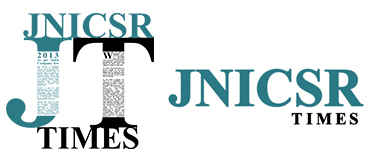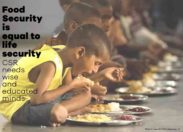To promote the Good Health for all agenda on September 25th 2015, countries adopted a set of goals to end poverty, protect the planet and ensure prosperity for all as part of a new sustainable development agenda.
For the goals to be reached, everyone needs to do their part: governments, the private sector, civil society and other individuals who need to come together and work towards the common goal. Across the globe, the path to quality health for large proportions of their population is fraught with difficulties.
According to Global Hunger Index report “India is ranked 100th out of 119 countries, and has the third-highest score in all of Asia — only Afghanistan and Pakistan are ranked worse.” It further stated, “At 31.4, India’s 2017 GHI (Global Hunger Index) and hunger is affecting India overall health.
The health condition of the people is a mirror of country’s development index and is determined by a variety of factors – among them are social, economic, dietary, lifestyle, environmental, locational, institutional, and awareness. The people who are more affected are those who have low income or are living in remote area.
Malnutrition
In India the state of hunger and malnutrition is scary. Hunger is leading several challenges in India , Children and youth are suffering from serious nutritional deficiencies which is affecting overall health condition of an average Indian.
In India 38 percentage children are underweight as compared to age , 58 percentage of children aged between 6 to 59 months are anemic. Malnutrition in children under-five also results in nearly half of the 1.3 million deaths occurring in the country each year Data on anaemia show that 56 percent of young girls and 30 percent of young boys in the age group of 15-19 years are anaemic in 2015.
Figure 1: Infant Mortality Rate in India, 1994-2013

Figure source: CBHI. National Health Profile, 2015, p. 19; Data source: Registrar General of India. SRS Bulletin, September 2013; Note: IMR in per 1,000 live births.
Figure 2: Nutrition and Anaemia Status of Children in India

Source: NFHS – 4, 2015-16; Note: Data on anaemia pertain to children aged 6-59 months.
In India Undernourished person out of total population is decreasing from 1990-92 to 2014-16 it was 24 percent to 15 percent respectively. Same in Maternal mortality ratio from 398 in 7997-98 to 167 per thousand in 2011-13 and infant mortality rate from 80 in 1991 to 41 per 1,000 live births in 2015-16, and under-five mortality rate from 115 in 1991 to 50 per 1,000 live births in 2015-16.
We are improving day by but we are still far behind to achieve the development goal. To address these issue the govt of India lunch Integrated child development Services (ICDS), due to which there is an improvement, but challenges are being observed to ensure the quality food at anganwadi, timely supply food etc.
In order to improve the health condition we need to improve our Anganwadi facilities to tackle the health issue in India. We need to involve more and more community participation, organise programs, improve exposure to community and worker to new technic like tracking the growth of every child and many other.
Secondly, we need to build the capacity of the Village child development centre. Third, the Politician need to focus on this issue and invest more in health sector.
For same they need to do advocacy and bring more budgetary allocation in health sector. In India, schemelike ICDS, data show that the budgetary allocations have decreased over time. Between 2014-15 and 2015-16, financial allocations were halved from INR 166 billion to INR 83 billion.
Central Budgetary Allocations for Integrated Child Development Services Scheme

Many of the reasons for the occurrence of malnutrition, as well as the solutions to overcome the challenge are known. Attention, however, needs to be paid to understanding what prevents the nation from achieving its goals related to nutrition. Undoubtedly, the agencies of State governments have to adopt a comprehensive and coordinated multi-sectoral approach, which is formulated by taking into account the varied nature of local-level challenges. They have to demonstrate better governance, too. For its part, civil society must respond in a responsible manner. In particular, attention needs to be paid on building neighbourhood health and nutrition profiles and carrying out interventions based on identified needs.Source: Ministry of Women and Child Development. Press Information Bureau releases, 19 March 2015 and 1 February 2017.
So there is need that government should appoint a commission which combines of expert people who can recommend for the health care system and monitoring its performances. Secondly we as a country need to develop and implement nation standard for examination on basis of same can be monitored. Third in India, we have lot of private company who do issuance but India need state interventions and need to protect them through simple step so that everybody can access the same. Govt need to find ways to provide medical insurance converge to the population at large with stepwise strategy. It is healthy to have competition in healthcare, and provide health insurance to the millions who cannot afford it.
India needs to :
Develop multi-specialty group practices that have their incentives aligned with those of hospitals and payers. It is much easier to teach the techniques of sophisticated medical care to a group of employed physicians than it is to physicians as a whole. It is also important that doctors are paid adequately for what they do. Finally yet importantly India Need to have more health management professional who can manage all activity, which will effectively reduce the talent gap for leadership in this area.
References
- UNICEF, WHO, World Bank Joint Child Malnutrition dataset, updated May 2017. Available from: https://data.unicef.org/topic/nutrition/malnutrition/
- Giri, Rujuta and Vanisha S. Nambiar. ‘Dietary habits, parental history and dual burden of malnutrition among affluent school going children’, International Journal of Current Research, 8 (5): 31446-31451, May 2016.
- Bierly, Allison. ‘Certain foods linked to long-term weight gain’. National Institutes of Health, 11 July 2011.
- FAO, IFAD and WFP. The State of Food Insecurity in the World. Rome: FAO, 2015.
- FAO, IFAD and WFP. Ibid; International Business Times. ‘India has most number of hungry people in the world: Report’, 31 May 2016.
- Data on different nutrition indicators are generated through National Family Health Surveys (NFHS). So far, four rounds of surveys have been conducted, i.e., NFHS-1 (1992-93), NFHS-2 (1998-99), NFHS-3 (2005-06) and NFHS-4 (2015-16).
- IFPRI. Global Nutrition Report, Nutrition Country Profile – India, 2015: data beyond 2006 are not available.
- NFHS – 4. 2015-16. Anaemia implies deficiency of red cells or of haemoglobin in blood, which causes weakness.
- The Indian Express. ‘Health ministry kicks off programme to reduce anaemia among adolescents’, 30 December 2015.
NFHS – 4. 2015-16; According to the WHO definition, a BMI of less than 18.5 kg. per square meter indicates severe thinness.







Leave a Reply